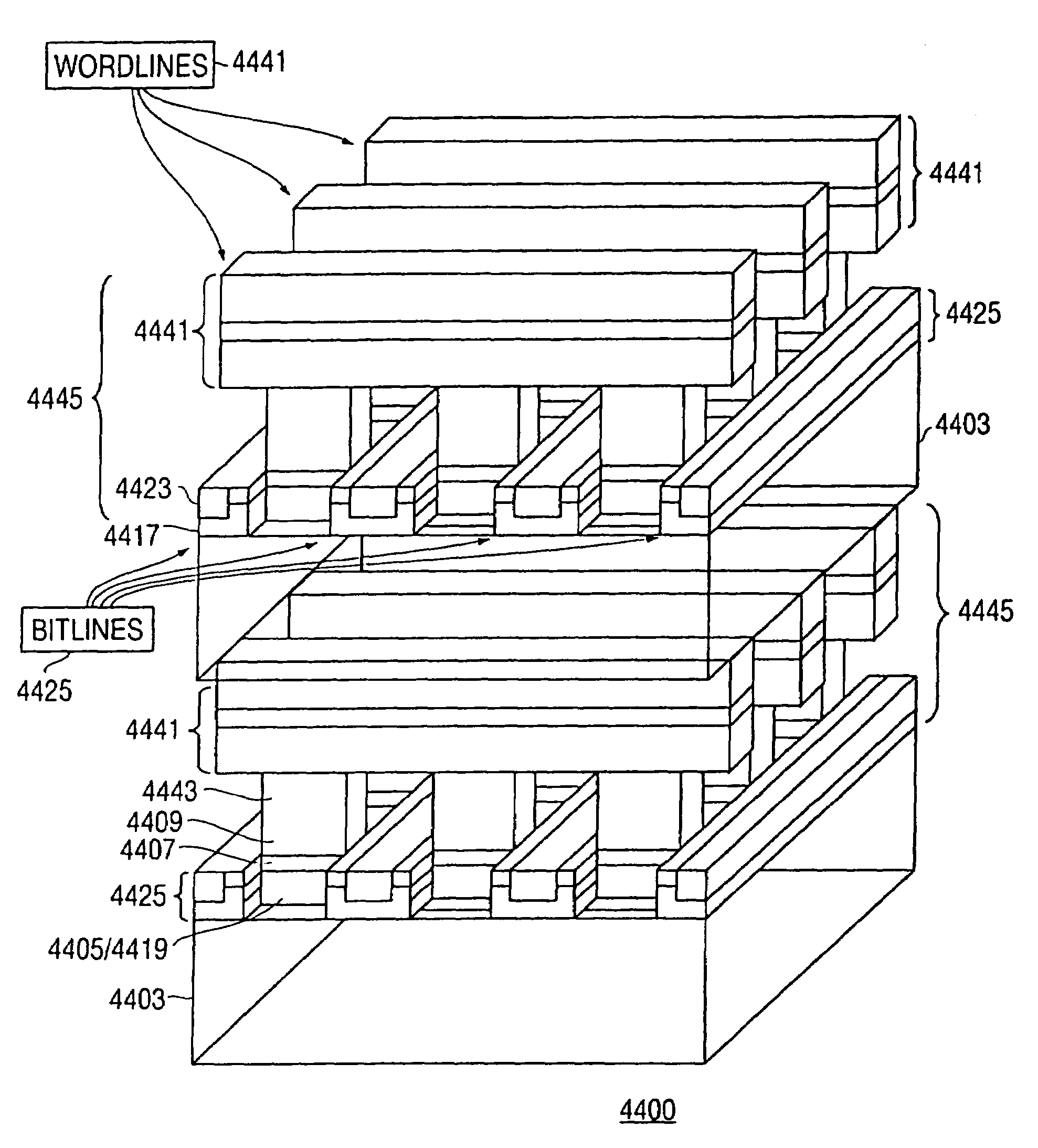Rail stack array of charge storage devices and method of making same
a charge storage device and rail stack technology, applied in the field of three-dimensional tft arrays, can solve the problems of single silicon plane, limited data storage to the number of devices, and less than the optimum cell density
- Summary
- Abstract
- Description
- Claims
- Application Information
AI Technical Summary
Benefits of technology
Problems solved by technology
Method used
Image
Examples
second embodiment
[0123]As will be discussed below, the charge trapping memory device of the present embodiment can be fabricated with one of two general structures. In one embodiment the charge storage medium is formed adjacent to the semiconductor region and in a second embodiment the charge storage medium is formed above or below the semiconductor region.
1. A Three Terminal Pillar Memory with Adjacent Charge Storage Medium
[0124]An embodiment of the present invention is a three terminal nonvolatile stackable pillar memory device. A pillar memory device 100 in accordance with this embodiment of the present invention is broadly illustrated in FIG. 1A. Pillar memory device 100 includes a first contact region 102 formed on a first input / output (I / O) 103 conductor formed on or above a plane (x-y) of a single crystal substrate 101. A semiconductor body 104 is formed directly on the first contact region 102 and a second contact region 106 is formed directly on the body 104. A second I / O conductor 116 is f...
first embodiment
[0180]Referring to FIG. 30, the invented memory cell is illustrated disposed in a p-type substrate 2930. A diode (steering element of the cell) is formed in the substrate comprising an n− region 2932, doped, for instance to a level of 5×1016–1018 cm−3, and a p+ region 2931, doped to >1019 cm−3 formed within the n− region 2932. These regions may be formed with well-known methods such as diffusion or ion implantation.
[0181]A storage stack comprising a dielectric (e.g., oxide) region 2933, trapping layer 2934 and a second dielectric (e.g., oxide) region 2935 is formed on the region 2932.
[0182]The dielectric region 2933 may be a grown oxide layer or a deposited silicon dioxide region. When comprising oxide, this region may be 1–5 nm thick. Ordinary processing may be used to form these regions.
[0183]The trapping region 2934 and the other trapping regions discussed in this application may be formed from a compound of nitrogen as well as other materials. In the prior art, silicon nitride (...
fourth embodiment
[0255]In a preferred aspect of the fourth embodiment, the top surface of the upper portion of the floating gate 4310 is textured or roughened to further increase the capacitive coupling between the floating gate and the control gate / word line. For example, at least the upper portion of the floating gate 4310 may be made of hemispherical grain silicon (HSG), or the upper surface of the floating gate may be roughened by etching or coarse polishing. In other words, the upper portion of the floating gate may be textured or roughened similar to the texturing or roughening methods used to texture or roughen bottom conductive plates of DRAM capacitors.
[0256]While the first through fourth preferred embodiments describe and illustrate a TFT EEPROM nonvolatile flash memory array, the present invention should not be considered to be so limited. For example, rather than a self aligned word line in a TFT EEPROM array, any gate line may be self aligned to a MOSFET (i.e., metal oxide semiconductor...
PUM
 Login to View More
Login to View More Abstract
Description
Claims
Application Information
 Login to View More
Login to View More - R&D
- Intellectual Property
- Life Sciences
- Materials
- Tech Scout
- Unparalleled Data Quality
- Higher Quality Content
- 60% Fewer Hallucinations
Browse by: Latest US Patents, China's latest patents, Technical Efficacy Thesaurus, Application Domain, Technology Topic, Popular Technical Reports.
© 2025 PatSnap. All rights reserved.Legal|Privacy policy|Modern Slavery Act Transparency Statement|Sitemap|About US| Contact US: help@patsnap.com



